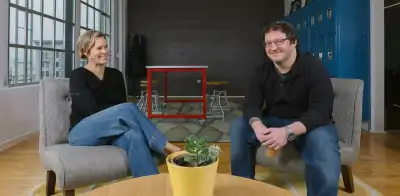“Part of the journey of this work is being willing to do the work… someone must be willing to take steps, to make some decisions.“ - Courtney Harge, Associate Director, Inbound Marketing, Fractured Atlas
In a world too often blind to systemic racism, Fractured Atlas walks the walk — setting an early example of how to create an equitable workplace. As a national arts service organization for artists, it is not surprising that Fractured Atlas is willing to shine a light on the uncomfortable, bringing light into darkness. That’s what artists do.
The Fractured Atlas mission is “to make the journey from inspiration to living practice more accessible and equitable for artists and creatives.” The organization provides fundraising tools and technology, educational resources, and personalized support to individual artists and arts organizations — serving over 900,000 over the past eight years.
As of six years ago, they embraced a much broader responsibility. Tim Cynova, Chief Operating Officer, wrote: “We realized that if we’re serious about our core mission — to eliminate practical barriers to artistic expression — then we must attack issues of injustice head-on… We believe that diverse organizations with inclusive policies and equitable practices promote honest discussions and the very best business decisions.”
These aren’t mere words; they’re a battle cry for action. Fractured Atlas has gone from being a white-led organization with 24 white and one Asian employee in 2012 to over 25-40% POC on staff. In 2016, the company committed to being anti-racist and anti-oppressive in everything they do, adopting Anti-Racism and Anti-Oppression (ARAO) Guidelines.
This dynamic nonprofit continues to actualize this commitment through a wide range of ongoing and innovative programs, policies, and initiatives — both internally and externally. Cynova says, “The work is never done, and we remain committed to doing it.”
Fractured Atlas’ efforts have not gone unrecognized. Nowadays, organizations reach out to Fractured Atlas leaders as consultants for the “how” of operationalizing diversity, equality, and inclusion commitments. Their extensive resources and in-depth blog posts are located on a companion website, aptly titled Work Shouldn’t Suck.
OKRs as a useful tool for transparency, alignment, and accountability
Responsibility starts at the top, with shared leadership between Cynova and Chief External Relations Officer Lauren Ruffin. They set an overarching strategy “made more concrete and practical through the development of quarterly, organization-wide Objectives & Key Results (OKRs).”
Fractured Atlas doesn’t have specific OKRs for ARAO efforts, per se. Cynova explains, “The company’s commitment to equality is so embedded in our culture that we use anti-racism as a lens to overlay on all of our OKRs. OKRs show our priorities, and we need to constantly examine [them] to make sure we are prioritizing anti-racism anti-oppression work.” An ARAO lens is applied to budgeting, hiring practices, communication tools, compensation, paid holidays, and a host of other decisions that are often reflected in OKR goals.
Cynova says, “OKRs have been a useful tool to help with conversations, transparency, accountability, and goal setting related to equality throughout the workplace.” Noting that the organization went entirely virtual last year, he says that “especially for newer managers, it’s a tool that they can use to have the conversations about what’s important for people to do, how you use those conversations to build trust.”

If you can’t see it, you can’t fix it
Everyone in Fractured Atlas shares their OKRs using Google Sheets in an Institution Team Drive for all to see. Nicola Carpenter, Associate Director, People Operations, and resident OKR guru, says, “One of the most powerful things about OKRs is that they are transparent for the organization. As my colleague, Courtney (Harge) says, ‘White supremacy culture and oppression are like water, and our organizations are the boats. The “water” will seep in through any cracks [in structures, process] that you can’t see. And if you can’t see it, how can you change it?’ OKRs helps make [ARAO] visible, and also then helps prioritize things within our organization.”
Carpenter observes the real power in embedding anti-racism enterprise into OKRs manifests as revisiting vital questions and priorities quarterly: “How did we decide that those are important? What are these metrics that we’re focusing on and what are we leaving out when we’re focusing on those things? Are you looking for ways to embed ARAO into those decision-making processes?” This internal “Pause for Equity” helps people get on the same page.
Checking ARAO priorities with OKRs
At Fractured Atlas, accountability for ARAO work is reinforced throughout the organization by regularly building anti-racism conversations into the work day. That’s part of the reason why, in 2016, Fractured Atlas implemented a two-party caucus system, one for white team members, and one for BIPOC team members.
Caucuses are meetings explicitly around shared identities, and they exist to ensure safe spaces for reflection, conversation, and growth. As Harge explains, “The caucus is a space that should actively (and constantly) affirm that People of Color are whole as a baseline, since the majority of messaging likes to indicate otherwise… This not only flips the dominant dynamic, but also emphasizes that fixing oppression is primarily the oppressors’ responsibility.”

Carpenter writes, “As white folks, we need to stay accountable to our colleagues of color but we also need to do work ourselves, in every department and team. Caucusing is one way of committing to regularly building anti-racism conversations into the work day and building in forms of accountability.”
Carpenter makes no secret that the work is a challenge. “So many organizations are making statements like ‘we stand with Black Lives Matter,’ we want to address racism within our organizations. But what’s the next step? You’re making that commitment, but how is that embedded into your values, in the actual work you’re doing on a day-to-day level? That’s one place where OKRs can be helpful.”
As one way to check that they are keeping non-white team members whole, the white caucus has established “accountability buddies” who review individual OKRs to ensure that they are not inadvertently detrimental to the nonprofit’s ARAO priorities. Carpenter shares, “one of my Key Results was “6 People Team Blog Posts have been published… The accountability buddy I worked with helped me put in place a plan to draft these blog posts that kept ARAO at the forefront.”
External goal-setting: OKRs for tomorrow’s leaders
Fractured Atlas’s ARAO goals are also reflected in their work outside the office. With a background as a lawyer and in nonprofit advocacy work, Ruffin brings another perspective to the leadership team. In response to protests after the 2016 election, Ruffin had a big idea how to hold artists accountable for the change that they wanted to see in America. Fractured Atlas would train them to run for elected office.
Ruffin reflects, “I made an OKR about doing a survey. There was one question that asked: Have you ever thought about running for office? If so, what support do you need? That one OKR turned into multiple OKRs over several quarters.”
The Artists Campaign School was born in Detroit in Fall 2017, followed by a second 2019 cohort in Chicago. The experience was an all-expenses-paid, intensive three-day training for artists to gain the skills and knowledge necessary to run for political office and win. Speakers included some of the biggest and brightest campaign veterans like President Obama’s finance chair, and seminars tackled basics of campaigning from setting up legal entities, how to target voters, to fundraising and messaging.
Over the last three years, the program has trained about 70 artists to run for office. More than half the graduates are people of color, and approximately two-thirds identify as female.

Ruffin chuckled as she listed multiple reasons why this initiative was such a good fit. “Artists are passionate, knowledgeable about issues like education, they’re able to tell their story and think outside the box. Artists can take nothing and make something wonderful, they can work across the aisle and consider different viewpoints.”
Pretty cool results started by a lone OKR, admits Ruffin, who once likened OKRs to going to the dentist. She doesn’t like doing them, but recognizes that they work. “We’re a relatively small organization that serves, depending upon how you count, anywhere from 5,000 to 75,000 artists. Trying to keep track of all the work that we’re doing just to keep plugging forward on a daily basis… dammit it’s valuable.”
If you’re interested in starting our OKRs 101 course, click here.



